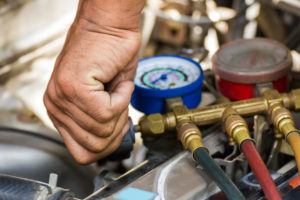The Air Conditioning system in a car is the last thing any driver would worry about. Whilst these efficient systems are less susceptible to failure, they could become the most troublesome parts when neglected.
If you have been experiencing warm air from your AC vents instead of the usual cool breeze, then it is high time you considered an AC recharge. Even if everything seems fine with your ventilation, you should still consider having occasional check-ups and servicing.
Most people are oblivious that a persistent or recurrent AC problem could end up damaging the main compressor. If you asked me, preventing a dire Air con situation would be much better than mitigating one. Don’t you think?
Read through our detailed analysis and get to know all the best practices, techniques, and ways of optimising your car’s air conditioning performance.
What is Air Con Recharging?
For you to have a consistent flow of cool air amidst the Summer heat waves, you need to ensure your refrigerant levels are stable all through. This is where recharging comes in.
The process basically involves replenishing your conditioner with a special type of refrigerant, based on the type and make of your vehicle.
Think of it like refilling a flat tire, or any other inflatable object for that matter. Unlike home air conditioners, recharging a vehicle’s air con is a bit more complex, and has many implications if not done in the right way.
With the right tools and proper guidelines, you can perform this yourself. However, we highly recommend involving a professional due to the many factors involved.
Understanding an air conditioner
Before learning how to recharge the air con, you have to understand how it works, more so how the parts complement each other. Here is a brief explanation to help you put everything into perspective.
When the AC is turned on, fresh air from outside is passed over a condenser (inside the system) and changes the refrigerant from gas to liquid form. In the liquid state, a drier is used to remove impurities and then passes it to the thermal expansion chamber, allowing the driver to control the temperature levels.
Finally, the liquid is evaporated and the vapour is passed into the interior as cool air. Meanwhile, the refrigerant is transformed back to its initial gaseous state to start the process all over again.
Without enough refrigerant, your conditioner will pass warm air, putting the whole system at risk in the long run.
Advantages of recharging your air con
- Guarantees cool refined air throughout
- Defrosts the windshield effectively
- Flexible moderation of air temperature inside the car
- Ensures the engine and other components are in good condition
Recharging your car’s air con
If you are a complete novice, don’t risk your personal safety or vehicle’s condition. Simply get yourself a technician and have your problem fixed. You have to understand that a car has numerous parts that have to work in sync; if not, things could fall apart.
Nonetheless, recharging your conditioner may not be the ultimate solution some times. There are numerous cases of people who have experienced problems even after recharging their conditioners. This is commonly caused by gas leaks.
Even the tiniest leak could render all your refilling efforts useless. Checking for these gas leaks can be done by:
- Conducting a Dye test – involves injecting a coloured dye into the AC system, and using any type of UV light to observe leaks. Any fluorescing area will symbolize a leak.
- Bubble method –used to detect leaks in car tires and other inflatables. It works by applying a soapy solution to the suspected areas which, if affected, will produce bubbles
- If leaking seems to occur in multiple points, you could call a mobile technician or take the car to a garage that specialises in air con repair.
Using an AC sealant could fix minor leaks. For bigger leaks, a specialist would be able to help out.
The DIY process of recharging demands accuracy and skill. All the same, anyone who is familiar with the mechanics of a car should feel comfortable following the simple procedure below:
- Turn off the conditioning system and gathering the required tools- pressurised refrigerant, pressure gauge, safety gloves, and glasses. (it is important to always have protective gear on)
- Prepare and assemble the recharging kit
- Locate and clean the pressure port
- Test pressure and measure the required amount of gas
- Refill the refrigerant
- Confirm the amount of pressure
Frequently Asked Questions
- How often should I recharge my AC?
Most manufacturers recommend doing it every two years. However, it also depends on your general usage, fuel consumption, and the environment you are in. If you feel that your intake is high, there is no harm in scheduling frequent visits from a mobile air conditioning specialist.
- What are the signs of a leaking refrigerant?
Leaks may be characterised by:
- Frozen coils
- Reduced or total loss of cooling power
- Hissing sounds from under the bonnet
- How long does the air con recharge take?
Completely removing old gas and refilling the system with new gas could take up to 45 minutes, but it all depends on the type of vehicle you have. For larger sophisticated cars, the process could go up to 1 hour. If a mobile air conditioning engineer who specialises in this sort of work it tends to be only 5-10 minutes.
Overall
Car air conditioning should be valued and treated like any other perishable resource. Implementing the mentioned tips could set you off a long way, and help you improve the life span of your vehicle.
There is no better time to recharge your Air Con. Give a mobile air conditioning engineer a call. If you would like to speak with us for advice and a quote, please call us on 01606 557 744.
- Mobile Air Con Recharge - June 28, 2019


